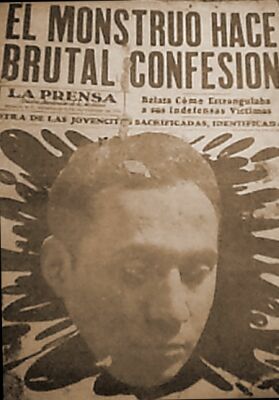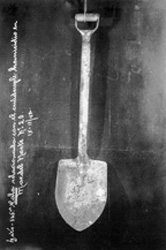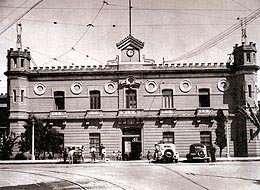(no subject)

The building pictured above is still refered to as "Facultad de Ciencias Quimicas" (Faculty of Chemical Science), even though it hasn't been the faculty in over twice my lifetime. It is located near Tacuba in Mexico city, and just a few blocks away from my house. A few years ago the "Fundación Roberto Medellin", whoever they are, seems to have put their offices there, however before that, with the exception of at most a couple of months, the building had been abandoned. Even now judging from what you can see from the outside it seems most of it is still abandoned.
It's a big building though, not something that would usually stay abandoned for so long, especially in Mexico, so what happened? Well, there is an interesting story behind the building. In a way you could say it's haunted, or at least cursed, or at least that's what many people say and think.
It all began with something that could now be considered a legend of Mexico city, except this Legend was all true. It is about probably the most famous serial killer in Mexico. While perhaps not as prolific in his murdering as other serial killers, with 4 murderers according to some sources, and about 8 according to others; his story is delicious mix of Jack the ripper and Dr. Frankestein, in the most feasible way that such things could happen, especially in a place like Mexico. To quote a good friend "Mexico is Shady". After doing some bibliographical research I haven't been able to sustain every single event of the story (though I could for most). I don't care, since I am considering it a legend, being slightly unaccurate historically is not a capital sin.
The year was 1942 and Gregorio "Goyo" Cárdenas Hernándes was a 26 year old physics student in the Chemical Science faculty of the National University. He lived in a house on a street called Mar muerto (Dead sea) not far from the faculty. He had a young girlfriend that, as far as I know, was not a classmate. He was a good student, though perhaps not outstanding.
At one point, and even though he was a physics student, he came up with a theory, a devised method for bringing people back from the dead. He was quite convinced he could do it, he just needed to test it and prove the scientific comunity and the world it'd work.
The problem was, of course, that you need a dead person in order to prove that you can bring people back from the dead. The National University, like many others did and do, had a morgue with a variety of corpses readily available for research or education. I would venture to say he did try those and I'll furhter venture to say he failed in bringing them to life. He may have discarded those results, or perhaps attributed them to the age of the corpses, After all, who would expect a heart, kidney, longue, etc... to work again after it's been submerged in a formaldehyde solution for months?
So he needed fresh corpses, but those are not easy to come around, so he must've came to the conclusion that he had to get them himself, and the way to do it was not digging up graves, those would've been dead for days already. He had to kill them himself.
I don't think his girlfriend was the first to be killed, but she certainly was one of them. The rest were all hookers. It is arguable wether he had sex with them before killing them, although he seems to have started his sex life at 11, so it's definitively not out of the question.
His modus operandi was apparently killing the females in his house in dead sea street, transport them to the faculty to perform his experiments and, failed that, he took them back to his appartment to bury. There's speculation about wether or not some were buried in the faculty.
Now I must stop to highlight something interesting about his characteristic. Upon hearing about these murderers one might wonder why he didn't use animals for his experiments. After all, it was the 40's, it was socially acceptable to do that kind of things, and animals would be easier to get and kill, and it would not have even been illegal. It's arguable that it would even be simplier to bring them back, since they should be more simple beings, or so it was thought at the time. Well, turns out that even being a cold blodded killer, Goyo Cardenas loved and respected animals. He had a guinea pig in his house (that he did use for other experiments) and one time, when his girlfriend was over, it died. That made him very sad and he decided to give proper burial to the animal. It was found furthest from the murdered women, which suggests they already were there and he didn't want his girlfriend to see them. Apparently after burying the guinea pig he felt an urge to murder her, but (at least that time), he resisted it. Could it be that he wanted to rush things to see if he could bring her to life, in order to repeat the procedure on his guinea pig if he succeeded?
In any case, he loved animals.
Eventually the police found out about him and aprehended him, I don't know the specifics of how that happened, but I know that once the police had him the case became quite public. The newspapers named him "El estrangulador de Tacuba" (the Tacuba strangler). Everybody followed the news. To cite an article I found, "In 1942 there were only two headlines in all of Mexico's newspapers: World War II and the Tacuba strangler"

The police was quite effective back then in Mexico city, they gathered all evidence they could find on him, including the shovel he used to dig the holes where he buried the women, and his diary, which proved crucial during the trial and discussion after the trial.

The police investigation paid off, and he was finally found guilty and given the maximum penalty allowed by law: 40 years in Lecumberri prision.
Lecumberri, "The black palace", was probably the most important prison in Mexico in the 20th Century There are many stories about it, and it's a part of Mexican culture. It was built by Porfirio Diaz and finished in 1901. It is a beautiful building on the outside, though as a prision it was kind of creepy. It remained a prison until the late 70's, when it was shut down and later turned into the National Archive. It's featured in stories (real and ficticious) and even many movies of the Mexican cinema's "Golden years".

Goyo Cardenas was assigned to the psychiatric ward, since his diary revealed that he was psychotic, among other disorders... Even epileptic. It is said that in one particular instance he attacked a woman but only killed her while having an epileptic attack, which sounds implausible to say the least. In time he claimed that he was going through a temporary phase and was cured, and asked to be transfered to the regular part of the prison, request that was refused. Some time after that he broke out of Lecumberri, and in a story that could easily be taken out of Police Novel from the time, he turned himself in to the most outstanding detective in the force, in exchange for being placed in the regular part of the prison, which was granted finally.
Back in prison he studied law and graduated priminently in a few years. His goal was to cut his sentence drastically, but he failed, of his 40 years he managed to cut it down to 35. Failed that, he used his newly acquired knowledge to review files and paroles for other inmates, helping release many poor, innocent people.
35 years after his imprisonment, in 1977, he was released at 61 years of age. He opened an office near Lecumberri and continued helping poor people in legal cases, even after Lecumberri was shut down, and for almost the rest of his life, which lasted about 20 years more.
He became a sort of a hero for his humanitarian work helping defend poor people, and because of that at one point he was summoned to the "Congreso de la Unión" (House of representatives and senators?) and received high honors. The man who had been sentenced to 40 years in jail because of being a serial killer.
That's about the end of the story of Goyo Cardenas, who passed away in 1999, however that doesn't say much about the faculty of Chemical Science.
After the murderers, the faculty was shut down, or rather relocated. Perhaps the plans weren't to keep it closed permanently, however; after Ciudad Universitaria (University city? the main Campi of the National University) in the early 50's, there was no real need for a faculty that was so far from the main campi (over an hour away with the transportation back then). That didn't matter though, people were scared of that building, to know that this psycho had murdered women and had them there, perhaps in more than one sense, creeped people who prefered to just stay away. Sadly I don't have an older picture, but before the Roberto Medellin foundation painted the buildings, and put that white sign, the place really did look very creepy.
The University owned, and may still own, the land though, and wasting land because people can't forget murders that happened so long ago, even after the murderer was released and honored by the congress is not something that looks very good in audits, especially since there is a /need/ for schools in the city. Having all that in mind, the University, who also owns a series of high schools across the city, attempted to turn it into a "Popular" high school, or a reject school. They attempted that repeatedly; just in my lifetime I remember 3 or 4 attempts, they all ended the same way: The place would remain open for a week or two (actually it was a day or two when the last attempt I remember took place), and then the students would mutinize, wreck the school including breaking all the windows, and do all sorts of rebellious acts, such as taking public busses and wrecking them as well after driving them around (or having the drivers drive them around, of course making them by force). Fights broke in and outside the school and for a day or two the place would become a real war zone (and remember it's very close to my house; I remmeber the abandoned busses afterwards). Time after time, they'd shut the place down after those events, only to try again many years later.
Is this a really haunted building? Cursed?
Well, I'd say maybe, but the whatever foundation has lasted a few years there already, so they must've broken the spell... that or they're doing something illegal there and it's a facade... or something, whatever that adds to the story and legend of the place.
I typed this entry twice. I started early, with many interruptions and when I was over halfway done my computer crashed and I lost it. I have the Firefox "session saver" plugin, but I disabled it because it was slowing things down, bummer. The second try took 2 hours to write, with only a few interruptions.
Among other sources, I used an article from an El Salvadoreñan newspaper to check and gather facts.